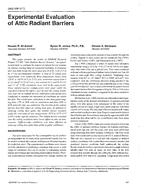Presents the results of ASHRAE Research Project RP-577, “Attic radiant barrier systems”, an experimental study to evaluate the impact of radiant barrier systems on summer cooling loads in residential buildings. A simulated attic was built inside the entire area of a 24-ft by 12-ft (7.3-m by 3.7-m) environmental chamber. A total of 72 steady-state experiments were conducted. Roof temperature varied from 120degF to 160degF (41degC to 71degC), attic ventilation varied from 0 to 2.0 cfm/ft2 (0.01 m3/s.m2), and nominal R11 and R19 (2.0 and 3.3 m2.degC/W) insulations were used in the experiments. Three radiant barrier configurations were used – under the roof deck between the rafters, directly over the ceiling insulation, and with no radiant barrier. Additional experiments were conducted to examine the movement of ventilation air inside the attic. The results show reductions in attic heat gains ranging from 17% to 26% with no ventilation and from 24% to 42% when the attic was ventilated. The location of the radiant barrier had little effect on ceiling heat gain. In addition to reducing ceiling heat gains, the radiant barrier mounted under the roof reduced attic temperatures 10degF to 15degF (6degC to 8degC) under typical conditions. The radiant barrier mounted over the ceiling insulation had a lesser effect on attic air temperature. Soffit-to-ridge ventilation was more effective in reducing ceiling heat gains than gable-to-gable ventilation.
KEYWORDS: year 1996, experiment, calculating, attics, foils, heat gain, solar heat gain, cooling load, summer, climate chambers, steady state, air temperature, thermal insulation, air movement, ventilation, performance, ceilings
Citation: ASHRAE Trans. 1996, vol.102, part 1, paper number 3962 (RP-577), 297- 306, 10 figs., 2 tabs., refs.
Product Details
- Published:
- 1996
- File Size:
- 1 file , 1.1 MB
- Product Code(s):
- D-16538
